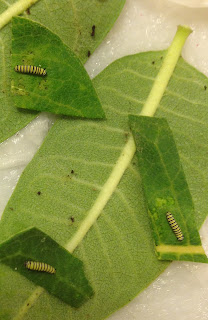 |
| Inverted Storage Box |
 |
| Half-Sheet Paper Towel Water Source Folded to Control Humidity |
 |
| Inverted Box with Holes Drilled |
Cover lid with one 1/2 sheet of wet paper towel folded for eggs and hatchlings, for small caterpillars, or for large caterpillars.
Place leaves (or parts) with eggs and hatchlings on the wet paper towel.
 |
| Hatchling and Egg |
 |
| Second Stage Caterpillars |
Do not place in direct sunlight near a window.
Reduce condensation by removing from sunlight or increasing ventilation around the box (or drill more holes if room air has poor circulation or high humidity).
After a week, all the eggs will have hatched. Development
takes place faster in warmer air. The monarchs in the lobby took 3-7 days longer
to develop than in our apartment.
Fold a wet 1/2 sheet of paper towel once on a clean lid (lowers humidity).
Add enough leaves to feed for 3-4 days or observe and, as needed, feed daily.
Transfer caterpillars onto new leaves.
 |
| Quintuplets, the Last Eggs Laid |
Fold a wet 1/2 sheet of paper towel once on a clean lid (lowers humidity).
Add enough leaves to feed for 3-4 days or observe and, as needed, feed daily.
Transfer caterpillars onto new leaves.
After another week the caterpillars will start eating more,
lots more.
Fold the wet 1/2 sheet of paper towel twice on a
clean lid (lower humidity).
Add enough leaves to feed daily or longer.
Remove the paper towel when feeding stops.
Change paper towel as often as needed for odor and tidiness. (Daily in the morning in the display.)
The caterpillars will assume a J shape before
becoming chrysalides.
Casting the last caterpillar skin is one of the most watched stages of development. A number of residents became skilled in judging the time for this to happen; about after breakfast.
 |
| Big Eaters |
Add enough leaves to feed daily or longer.
Remove the paper towel when feeding stops.
Change paper towel as often as needed for odor and tidiness. (Daily in the morning in the display.)
 |
| A Sleepy Chrysalis |
 |
| The Quintuplets with Development Almost Tied and in Near Perfect Spacing |
Casting the last caterpillar skin is one of the most watched stages of development. A number of residents became skilled in judging the time for this to happen; about after breakfast.
Emergence chamber.
For few monarchs, fasten a full sheet of paper towel
up the backside of the box and over the floor of the box for the new butterflies to climb up on.
For any number: Gently remove a chrysalis and silk webbing with forceps.
Tape or pin the silk webbing into an emergence chamber.
If the webbing fails, tie the uppermost black end of the chrysalis with a length of dental floss and then fasten into an emergence chamber (flight cage for large numbers).
The adult will emerge shortly after the chrysalis becomes totally transparent. Seeing the wings inflate is the most watched stage of development. Again residents became skilled in judging the time of the event. A good show is to have 10-20 emerge on the same day.
 |
| Taped by Dental Floss and Silk |
For any number: Gently remove a chrysalis and silk webbing with forceps.
Tape or pin the silk webbing into an emergence chamber.
If the webbing fails, tie the uppermost black end of the chrysalis with a length of dental floss and then fasten into an emergence chamber (flight cage for large numbers).
 |
| Two Chrysalides Ready to Emerge |
The adult will emerge shortly after the chrysalis becomes totally transparent. Seeing the wings inflate is the most watched stage of development. Again residents became skilled in judging the time of the event. A good show is to have 10-20 emerge on the same day.
1.
If the wings feel cool, they are not dry for
tagging or release. It takes about five hours. We released them about 3:00 pm.
2.
Put one butterfly in each rearing box for group
releases. Butterflies fly up and to
light. This makes it fairly easy to put a hand into the box below a
fluttering butterfly.
3.
Assist each person to open the box (unsnap the
lid) and to let the butterfly walk up
onto an upturned hand.
4.
Gently remove the box without disturbing the
butterfly.
5.
Most butterflies will remain on a hand for
several minutes.
6.
We let slowpokes walk up onto a nearby tree leaf or just picked them up by grasping the
front of both wings with thumb and forefinger.
7.
A good show is to assist several residents to
hold the butterflies at the same time. It took me a bit of practice to do this
quickly and quietly enough that four residents had a butterfly on hand at the
same time. Hold the box only at the lock point with one hand and release the
lock at the other end. This permits complete control of the opening and closing
of the box.
When things go wrong.
 |
| Ouch!! |
A dropped chrysalis is a broken egg.
Damaged caterpillars and adults bleed green.
Dark off-color caterpillars and chrysalides are usually sick and die from many causes. This increased as the season progressed.
 |
| What Happened to You? |
Caterpillars and chrysalides with slime strings reaching the bottom of the box have been parasitized with a tachinid fly larva (maggot). The white maggot or the dark brown puparium will be found undercover among the fecal pellets.
 |
| One to Three per Caterpillar Kill |
Running out of food overnight only extends the development period.
Don’t mash a butterfly between the box and lid. Let an escapee go.

No comments:
Post a Comment